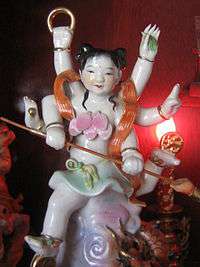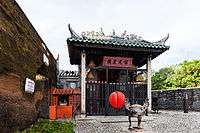Nezha (deity)
| Nezha | |||||||||||||||||||
_(15513109434).jpg) Nezha (on the left) in Fengshen Yanyi | |||||||||||||||||||
| Chinese | 哪吒 | ||||||||||||||||||
|---|---|---|---|---|---|---|---|---|---|---|---|---|---|---|---|---|---|---|---|
| |||||||||||||||||||
Nezha (哪吒) is a protection deity in Chinese folk religion. His official Taoist name is "Marshal of the Central Altar" (中壇元帥). He was then given the title "Third Lotus Prince" (蓮花三太子) after he became a deity.
Origins



According to Meir Shahar, Nezha is ultimately based on two figures from Hindu mythology. The first is a yaksha from the Ramayana named Nalakubar, the son of Yaksha King Kubera and nephew of the antagonist Ravana. The link to Nalakubar is established through variants in his Chinese name appearing in Buddhist sutras. The original variant Naluojiupoluo (那羅鳩婆羅) changed to Naluojubaluo (捺羅俱跋羅), Nazhajuwaluo (那吒矩韈囉), and finally Nazha (那吒). The simple addition of the "mouth radical" (口) to Na (那) changes the name to the current form Nezha (哪吒). The second figure is the child god Krishna. Both Krishna and Nezha are powerful children that defeat mighty serpents, Kaliya in the case of the former and Ao Bing in the latter. The Bhagavata Purana describes how Nalakubar was rescued from imprisonment within a tree by Krishna. A 10th-century Tantric Buddhist sutra mentions a child god that seems to be an amalgam of Krishna and Nalakubar called Nana (那拏). In addition, Nalakubar’s father Kubera was eventually absorbed into the Buddhist pantheon as the Heavenly King Vaiśravaṇa. Shahar notes that Vaisravana was somehow connected to the historical Tang Dynasty general Li Jing. This explains the name and position of Nezha’s father, the Pagoda-Bearing Heavenly King Li Jing.[2]
History
According to Fengshen Yanyi, Nezha was born during the Shang dynasty in a military fortress at Chentang Pass. His father was a military commander named Li Jing, who later became the "Pagoda-wielding Heavenly King". Nezha's mother, Lady Yin, gave birth to a ball of flesh after being pregnant with him for three years and six months. Li Jing thought that his wife had given birth to a demon and attacked the ball with his sword. The ball split open and Nezha jumped out as a boy instead of an infant. Nezha could speak and walk immediately after birth. He was later accepted by the immortal Taiyi Zhenren as a student. He had two older brothers, Jinzha, a disciple of Wenshu Guangfa Tianzun, and Muzha.
One day, the people of Chentang Pass asked for rain, and sacrificed much food to the East Sea Dragon King Ao Guang. The King rejected the food and required instead girls and boys to eat. He sent Ye Sha to capture for him a girl and boy. Nezha and two other children were playing by the sea when Ye Sha appeared and captured one of Nezha's friends. Nezha then fought him and injured him severely, causing him to return to the King and beg for someone else to take care of Nezha. The Dragon King sent Ao Bing, his third son, but the latter was slain by Nezha. Ao Guang called for his brothers and confronted Nezha and his family. He threatened to flood Chentang Pass and report Nezha to the Jade Emperor. To save his family and the people, Nezha committed suicide himself them carving up his own flesh and dismembering his bones "returning" these to his parents in repayment for the debt of his birth. The Dragon Kings then hosted a huge celebration.
After Nezha had committed suicide to return his body to his parents, he appeared in his mother's dream. In the dream, he asked her to build a temple for him, so that his soul would have a place to rest. This constitutes a link to Nezha's birth because the night before Nezha was born, Lady Yin had a dream where a Taoist put something into her bosom and told her to take this child. For both incidences, a dream was used to communicate a message.
His mother then secretly built a temple for Nezha and this temple later flourished. This temple became very well known and grew vastly because Nezha granted miracle cures to the sick and the crippled. However, Li Jing soon found out about this temple and burnt it down because he was still angry at Nezha and felt that he had already caused too much trouble for their family.
Li Jing burning the temple caused Nezha to desire his father's death. Thus, enmity between father and son grew. Nezha was later brought back to life by his teacher, Taiyi Zhenren, who used lotus roots to construct a human body for his soul and gave him two new weapons: the Wind Fire Wheels (風火輪) and the Fire-tipped Spear (火尖槍). With the reincarnation of Nezha by his master, Li Jing and Nezha fought many battles. However, Li Jing soon realized that his mortal body was no match for Nezha and so he ran for his life. On the run, he met his second son, Muzha, who fought and was defeated by Nezha. At this, Li Jing tried to commit suicide but was saved by Wenshu Guangfa Tianzun, who also contained Nezha. In the end, Nezha was forced to submit to his father by another deity, Randeng Daoren.
Nezha is often depicted as a youth, instead of an adult. He is often shown flying in the sky riding on the Wind Fire Wheels (風火輪), has the Universe Ring (乾坤圈) around his body (sometimes in his left hand), the Red Armillary Sash (浑天绫) around his shoulders and a Fire-tipped Spear (火尖槍) in his right hand. Sometimes, he is shown in his "three heads and six arms" form (三頭六臂). He has the ability to spit rainbows in some legends.
In mythology and literature
Nezha has frequently appeared in Chinese mythology and ancient Chinese literature such as Fengshen Yanyi (or Investiture of the Gods), although the story of Nezha conquering the sea is the most well known among Chinese households.
In Journey to the West, Nezha was a general under his father, "Pagoda-wielding Heavenly King" Li Jing. He fought the Monkey King, Sun Wukong, when the latter rebelled against the Jade Emperor. They became friends later.[3] Nezha made some appearances in the novel to help the four protagonists defeat powerful demons.
Nezha in other media

Nezha increased in popularity in 1979 with the film Nezha Conquers the Dragon King (1979), which had won an international award. On 30 May 2014, Google paid homage to the film with an animated doodle on their Hong Kong search engine's homepage.[4]
In 2004, China Central Television (CCTV) released a new children’s animated series The Legend of Nezha (2004), which ran for 52 episodes.
Nezha appears as an antagonist in the Chinese animated film Havoc in Heaven (1961; 1964), losing a fight to Sun Wukong.
Nezha appears as one of the playable characters in Koei's Warriors Orochi 3. In the game, Nezha is seen as a formidable foe who always defeats Lu Bu in duels. As a result, in several of the battle stages, Lu Bu is constantly obsessed in hunting down Nezha to engage the latter in duels - with the hope to win and therefore validating his own superiority and might.
Ne Zha is a playable character in the Multiplayer online battle arena video game Smite, where he is a melee assassin.[5]
On December 16, 2015, MMO Action game Warframe released a playable character named and themed after Nezha.
Religion
Nezha is worshipped in Chinese folk religion and is called "Marshal of the Central Altar" (Chinese: 中壇元帥) or "Prince Nezha", the "Third Prince".
As in traditional folklore, Nezha flies around swiftly on his Wind Fire Wheels, so he is also regarded as the tutelary god of many professional drivers, like truck, taxi, or sightseeing bus drivers. They tend to place a small statue of Nezha in the vehicles for a safe drive.[6]
The Xinying Prince's Temple in Tainan City, built in 1728, is the founding temple of the cult in Taiwan.
Taiwan's Techno Prince Nezha dance groups (Chinese: 電音三太子) were invited to perform in the opening ceremonies of the World Games 2009 in Kaohsiung and the 2009 Summer Deaflympics in Taipei, presenting a fusion of popular culture and Chinese traditional art.
Nezha is a well-known Taoist deity in Japan. The Japanese refer to Nezha as Nataku or Nata, which came from the readings of Xiyouji or Seiyuki (西遊記) in Japanese.
See also
References
- ↑ 國語辭典修訂本 (http://dict.revised.moe.edu.tw)
- ↑ "Nezha's connections to India Deities" (PDF). Archived from the original (PDF) on 2012-04-26.
- ↑ http://cdweinmann.tripod.com/glossary.htm
- ↑ "35th Anniversary of Nezha Conquers the Dragon King". Google Doodle Archive. Google Inc. Retrieved 2014-05-30.
- ↑ {cite web|url=http://www.smitegame.com/gods/ne-zha/
- ↑ http://www.taiwaninsights.com/tag/nezha-the-third-prince/
| Wikimedia Commons has media related to Nezha (deity). |